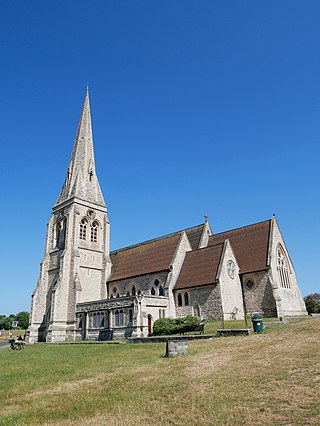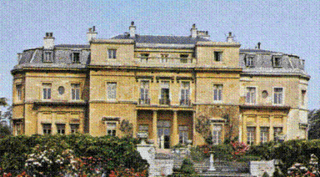
Blackheath is an area in Southeast London, straddling the border of the Royal Borough of Greenwich and the London Borough of Lewisham. Historically within the county of Kent, it is located 1-mile (1.6 km) northeast of Lewisham, 1.5 miles (2.4 km) south of Greenwich and 6.4 miles (10.3 km) southeast of Charing Cross, the traditional centre of London.

Greenwich is a town in south-east London, England, within the ceremonial county of Greater London. It is situated 5.5 miles (8.9 km) east-southeast of Charing Cross.

Sir James Thornhill was an English painter of historical subjects working in the Italian baroque tradition. He was responsible for some large-scale schemes of murals, including the "Painted Hall" at the Royal Hospital, Greenwich, the paintings on the inside of the dome of St Paul's Cathedral, and works at Chatsworth House and Wimpole Hall.

Greenwich Park is a former hunting park in Greenwich and one of the largest single green spaces in south-east London. One of the Royal Parks of London, and the first to be enclosed, it covers 74 hectares, and is part of the Greenwich World Heritage Site. It commands views over the River Thames, the Isle of Dogs and the City of London.
Westcombe Park is a largely residential area in Blackheath in the Royal Borough of Greenwich, South East London, England. It is bounded by the main London-Dartford railway line to the north, the Blackwall Tunnel southern approach to the east, the Blackheath common to the south and a road, Vanbrugh Hill, to the west.

Greenwich Hospital was a permanent home for retired sailors of the Royal Navy, which operated from 1692 to 1869. Its buildings, in Greenwich, London, were later used by the Royal Naval College, Greenwich and the University of Greenwich, and are now known as the Old Royal Naval College. The word "hospital" was used in its original sense of a place providing hospitality for those in need of it, and did not refer to medical care, although the buildings included an infirmary which, after Greenwich Hospital closed, operated as Dreadnought Seaman's Hospital until 1986.

Queen's House is a former royal residence built between 1616 and 1635. It was built near the now demolished Greenwich Palace, a few miles downriver from the City of London and is now in the London borough of Greenwich. It presently forms a central focus of what is now the Old Royal Naval College with a grand vista leading to the River Thames. The Queen's House architect, Inigo Jones, was commissioned by Queen Anne of Denmark in 1616 and again to finish the house in 1635 by Queen Henrietta Maria. The Queen's House was commissioned by both Anne and Henrietta as a place to display artworks they had accumulated and commissioned; This includes a ceiling of the Great Hall that features a work by Orazio Gentileschi titled Allegory of Peace and the Arts.
John James was a British architect particularly associated with Twickenham in west London, where he rebuilt St Mary's Church and also built a house for James Johnson, Secretary of State for Scotland, later Orleans House and since demolished. Howard Colvin's assessment of him was that of "a competent architect, but he lacked inventive fancy, and his buildings are for the most part plain and unadventurous in design".

Field Marshal Garnet Joseph Wolseley, 1st Viscount Wolseley,, was an Anglo-Irish officer in the British Army. He became one of the most influential and admired British generals after a series of successes in Canada, West Africa and Egypt, followed by a central role in modernizing the British Army in promoting efficiency.

Princess Sophia of Gloucester was a great-granddaughter of King George II of Great Britain and niece of King George III.

Luton Hoo is an English country house and estate near Luton in Bedfordshire and Harpenden in Hertfordshire. Most of the estate lies within the civil parish of Hyde, Bedfordshire. The Saxon word Hoo means the spur of a hill, and is more commonly associated with East Anglia.

Sir Gilbert Heathcote, 1st Baronet was an English merchant and Whig politician who sat in the English and British House of Commons between 1701 and 1733. He also served as the governor of the Bank of England and was Lord Mayor of London in 1711.

Sir Julius Charles Wernher, 1st Baronet was a German-born Randlord, diamond magnate, and art collector who became part of the English establishment.

Admiral of the Fleet Matthew Aylmer, 1st Baron Aylmer, of Covent Garden, Westminster, and Westcliffe, near Dover, was an Anglo-Irish Royal Navy officer and Whig politician who sat in the English and British House of Commons between 1695 and 1720.

White Lodge is a Grade I listed Georgian house situated in Richmond Park, in the London Borough of Richmond upon Thames. Formerly a royal residence, it now houses the Royal Ballet Lower School, instructing students aged 11–16.
Vice Admiral Francis Hosier (1673–1727) was a British naval officer. He was a lieutenant on Rooke's flagship at the Battle of Barfleur in 1693. He captured the Heureux off Cape Clear in 1710 and distinguished himself in action with the Spanish off Cartagena in 1711. He is chiefly remembered, however, for his role in the failure of the Blockade of Porto Bello, for which poor Government orders were largely responsible, during which he died of disease alongside thousands of his sailors.

Sir John Jennings was a Royal Navy officer and Whig politician who sat in the English and British House of Commons between 1705 and 1734. He commanded HMS Kent at Cadiz and Vigo in 1702 during the War of the Spanish Succession. He went on to be Commander-in-Chief of the Jamaica Station, then Senior Naval Lord and finally Governor of Greenwich Hospital.
Henry Hood, 2nd Viscount Hood (1753–1836) was an English peer. He is known for his relationship with Caroline of Brunswick.



















